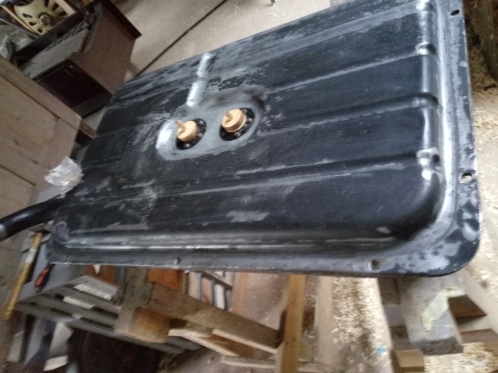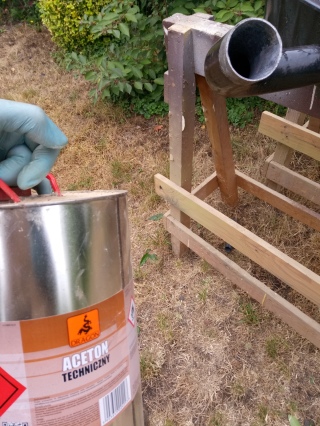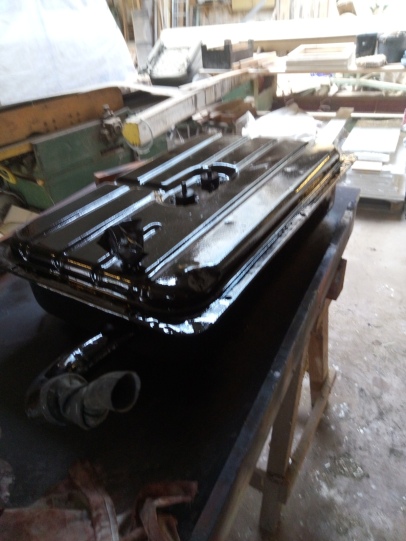Diesel being oily per nature, we could assume diesel fuel tanks should be naturally better protected than petrol fuel tanks. Nonetheless, diesel is affected by water too (hence the notion of winter diesel, etc). My Żuk being standstill often, I decided to treat the tank nonetheless with Restom® SUPERKIT.
The whole process is described in this (french) article by Pierre Legendre. To sum up this article:
- worse damage is often on the bottom part of a fuel tank;
- treatment kits varies in quantity of product depending on the tank to be treated;
- first drop the tank and remove the fuel, treatment must be done after welding/chroming but before painting;
- then degrease the tank with Restom® SDT 4060, mixed with hot-water, ratio of 0,5 litre of product for 5 litres of hot-water;
- if there is lot of dirt, you can add in the mix wood screws;
- turn around and shake the tank as long as possible for the product to work in every area; you might even let the product overnight, covered to keep it warm;
- clean the tank to remove any traces of the product, with hot water if possible;
- if need be, now you can weld the tank;
- remove the rust in tank with Restom® PAC 2030, mixed with water, ratio of half-half, for 30 minutes to 2 hours, even more if need be;
- once you are sure there are no more rust, clean the tank with water and dry it (compressed air for example);
- to even dry it more, put a few centilitres of aceton in the tank and shake it;
- remove any detachable parts (filters, etc);
- close every hole with some removable item, like corks, tape;
- “
- “
- “
- mix the resin with its hardener (the whole kit), in temperature between 15 and 25°C; the mix is usable for 1h30 to 2h; put the product in the tank at once; in case of resin drops on the paint, remove it without delay with denaturated alcohol;
- turn the tank on itself every now and then during 40 minutes so the resin recover every inside panel similarly; finish with the tank in its natural position, so there will be an extra layer on the bottom; after a few hours, remove the hole covers, check if no hole is blocked; let it dry one week at 15 to 25°C and you can mount it back and fill it with fuel.
The tank was already dropped off the vehicle. It was quite dirty:
I removed directly the fuel gauge and fuel lines elements:
The net at the end of the tube, sort of suction strainer, is in terrible shape, torn. The plastic joints are quite ugly too.
The small side plastic tube looks very dirty and oddly shaped too.
What about inside the tank? Hum, very brownish liquid but panels look fine:
Then I closed the openings. Screws within holes, simple (I suggest putting them just so they are fully within the hole thread but not more, so their own thread wont get any resin) . Being in a carpentry, it only makes sense to use carpentry-made wood corks… and an old tyre tube for the fuel entrance large tube:

Then, the tank was degreased. Yeah, in the quoted articles, it was done before closing the openings. But the quoted article was made for a motorcycle tank. Considering Żuk fuel tanks openings, it would have been a pain to manipulate the tank without having the producting flowing out at the time. So, as in the article, a ratio of 0,5 Restom® SDT 4060 for 5 litres of hot water. That a few times until product going out is crystal-clear.
Next step, the rust removal, half Restom® PAC 2030, half-water, the tank being turned in one direction or another during more than 2 hours.
Next step, drying. Drying it under the hot sun and finally by pouring a small amount of aceton (always beware with this product, go slowly to be sure not throw an amount unbearable to breathe around):
And finally, once it was clearly dry inside, I mixed the resin with the hardener and poured it in. And then turned around the tank every 3/4 minutes during less than a hour so to apply the mix as evenly as possible everywhere:
Then it was time for a layer of black paint (regular anti-rust black paint for outside, not automotive specific); to be perfectly honest, I actually put a first layer when it was drying, after the aceton step:

I was not such a good idea to let an extra layer of resin develop on the bottom: it considerably reduced the size of the sump at the bottom on the tank.
Then it was time to put back elements. And then I found nearly impossible to find replacements for the parts that I would have like to changed: no replacement for the part with the torn net (SMOK PALIWA NAKŁADANY I RURKA, 17-1104100); no replacement for the small white plastic tube (Króciec z uszczelką zbiornika paliwa, 17-1101117) except one looking clearly different on some Ukranian website, no replacement for the pads spacing the tank from the chassis.
I decided to stick with the odd white plastic tube, it is a breathing conduit, it should not matter that much.
The torn net was a concern though. I thought about putting some replacement that would improve ability to empty the tank properly like suggested on Grzmiący Rydwan. But it was unclear to me which item buy and how to put it in place. So, instead, I bought very cheap a “SMOK PŁYWAK PAJERO PININ 2.0 GDI” and salvaged its suction trainer (sitko, crépine in french) and attachement, that with very little work fit in perfectly in the Żuk tank (exact diameter of the tank openings):
Finally, regarding the pads between the tank and the chassis, their purpose is to increase the life and reliability of fuel system components “by isolating the fuel tank and pump, considering the vehicle fuel pump can emit noise when in operation, while the fuel tank itself experiences stress as it comes into contact with vehicle underbody and frame components“. I put in place construction gum pads bought very cheap for less than 2 euros:
Finally, everything was put back in place, along with refreshed metal fuel lines (rust cleanup and layer of paint):
+ kosztuje = 71,50 € (Restom®Superkit 25/40 pour réservoir de 25 à 40L; yeah, not quite the recommended amount since Żuk tank is 55l) + 4 zł (gum pads) + 45 zł (Pajero suction strainer) = 83 € ; Żukventure cost so far = 2356 + 83 = 2439 €























